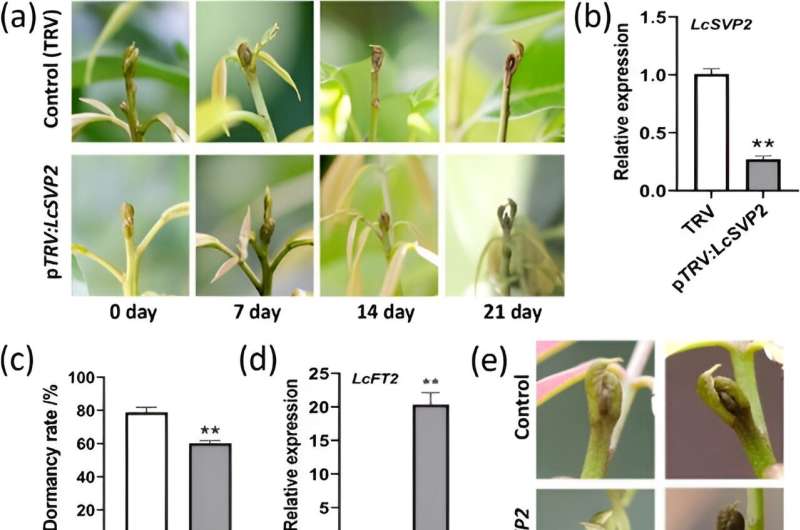This article has been reviewed according to Science X's editorial process and policies. Editors have highlighted the following attributes while ensuring the content's credibility:
fact-checked
peer-reviewed publication
proofread
Lychee's dormant dance: Genetic maestro LcSVP2 controls the rhythm of rest

Bud dormancy is a vital survival strategy for temperate fruit trees, helping them withstand unfavorable environmental conditions. However, in evergreen perennials like lychee, dormancy can occur even when conditions are ideal, presenting unique challenges.
Addressing these challenges requires a deeper exploration of the molecular mechanisms that control dormancy in evergreen species, like lychee, to improve agricultural practices and crop management.
Researchers at South China Agricultural University have detailed their findings in the May 28, 2024, issue of Horticulture Research.
The study centers on the MIKC type MADS-box transcription factor LcSVP2, a gene crucial for regulating dormancy in lychee terminal buds. The research also explores LcSVP2's role as a flowering repressor, providing fresh insights into its dual functions and potential impacts on the cultivation practices of lychee and other fruit crops.
The study identifies LcSVP2 as a pivotal regulator of dormancy in lychee terminal buds, with high expression levels observed during growth cessation and dormancy stages. Using a virus-induced gene silencing (VIGS) assay, researchers demonstrated that silencing LcSVP2 significantly delays dormancy re-entry, underscoring its essential role in this process.
Additionally, LcSVP2 acts as a flowering repressor, as its overexpression in Arabidopsis delayed flowering. The research also revealed that LcSVP2 interacts with another transcription factor, LcSMOS1, to co-regulate bud dormancy.
Both LcSVP2 and LcSMOS1 were found to respond to dormancy-enforcing hormones such as abscisic acid (ABA) and ethylene, highlighting their roles in dormancy regulation and offering new avenues for crop management strategies.
Dr. Ren-Fang Zeng, a senior author of the study, emphasized the importance of this discovery. "Understanding LcSVP2's dual role in dormancy and flowering opens new perspectives on the interconnected processes in lychee. This knowledge is essential for developing improved crop management practices, particularly in regions where lychee is a significant agricultural product," Dr. Zeng noted, underscoring the broader implications of the study.
The findings from this study are poised to have significant implications for horticulturists and agricultural scientists working with evergreen species.
By elucidating how LcSVP2 regulates dormancy and flowering, new strategies can be developed to better control these processes in lychee, potentially leading to improved yields and fruit quality.
Furthermore, this research paves the way for exploring similar genetic mechanisms in other evergreen perennials, which could substantially impact the cultivation of tropical and subtropical crops, supporting more sustainable agricultural practices.
More information: Meng-Meng Ma et al, MIKC type MADS-box transcription factor LcSVP2 is involved in dormancy regulation of the terminal buds in evergreen perennial litchi (Litchi chinensis Sonn.), Horticulture Research (2024). DOI: 10.1093/hr/uhae150
Journal information: Horticulture Research
Provided by South China Agricultural University




















